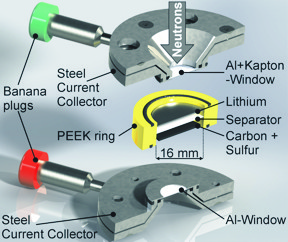Home > Press > Nanoparticles in lithium-sulphur batteries detected with neutron experiment
 |
| The operando cell was developed at HZB and allows to analyse processes inside the battery during charging cycles with neutrons. © S. Risse/HZB |
Abstract:
Lithium-sulphur batteries are regarded as one of the most promising candidates for the next generation of energy storage devices. They have a theoretical gravimetric energy density that is five times higher than that of the best lithium-ion batteries currently available. And they even work at sub-zero temperatures of down to -50 °C. In addition, sulphur is inexpensive and environmentally friendly.
Nanoparticles in lithium-sulphur batteries detected with neutron experiment
Berlin, Germany | Posted on September 6th, 2019However, their capacity so far has fallen sharply with every charge-discharge cycle, so that such batteries are not yet long-lasting. The loss of capacity is caused by complicated reaction processes at the electrodes inside the battery cell. It is therefore particularly important to understand exactly how the charge (sulphur) and discharge (lithium sulphide) products precipitate and dissolve. While sulphur precipitates macroscopically and therefore lends itself to examination by imaging techniques or X-ray diffraction during cycling, lithium sulphide is difficult to detect due to its sub-10-nm particle size.
Insight into this has now been provided for the first time by investigations with the BER II neutron source at the HZB. Dr. Sebastian Risse used a measuring cell he developed to illuminate lithium-sulphur batteries with neutrons during charging and discharging cycles (operando) and simultaneously performed additional measurements with impedance spectroscopy.
This enabled him and his team to analyse the dissolution and precipitation of lithium sulphide with extreme precision during ten discharge/charging cycles. Since neutrons interact strongly with deuterium (heavy hydrogen), the researchers used a deuterated electrolyte in the battery cell to make both the solid products (sulphur and lithium sulphide) visible.
Their conclusion: "We observed that the lithium sulphide and sulphur precipitation does not take place inside the microporous carbon electrodes, but instead on the outer surface of the carbon fibres", says Risse. These results provide a valuable guide for the development of better battery electrodes.
####
For more information, please click here
Contacts:
Antonia Roetger
Contact the expert:
Dr. rer. nat. Sebastian Risse
(030) 8062 - 43022
Copyright © Helmholtz-Zentrum Berlin für Materialien und Energie
If you have a comment, please Contact us.Issuers of news releases, not 7th Wave, Inc. or Nanotechnology Now, are solely responsible for the accuracy of the content.
| Related Links |
| Related News Press |
News and information
![]() Researchers develop molecular qubits that communicate at telecom frequencies October 3rd, 2025
Researchers develop molecular qubits that communicate at telecom frequencies October 3rd, 2025
![]() Next-generation quantum communication October 3rd, 2025
Next-generation quantum communication October 3rd, 2025
![]() "Nanoreactor" cage uses visible light for catalytic and ultra-selective cross-cycloadditions October 3rd, 2025
"Nanoreactor" cage uses visible light for catalytic and ultra-selective cross-cycloadditions October 3rd, 2025
Possible Futures
![]() Spinel-type sulfide semiconductors to operate the next-generation LEDs and solar cells For solar-cell absorbers and green-LED source October 3rd, 2025
Spinel-type sulfide semiconductors to operate the next-generation LEDs and solar cells For solar-cell absorbers and green-LED source October 3rd, 2025
Discoveries
![]() Researchers develop molecular qubits that communicate at telecom frequencies October 3rd, 2025
Researchers develop molecular qubits that communicate at telecom frequencies October 3rd, 2025
![]() Next-generation quantum communication October 3rd, 2025
Next-generation quantum communication October 3rd, 2025
![]() "Nanoreactor" cage uses visible light for catalytic and ultra-selective cross-cycloadditions October 3rd, 2025
"Nanoreactor" cage uses visible light for catalytic and ultra-selective cross-cycloadditions October 3rd, 2025
Announcements
![]() Rice membrane extracts lithium from brines with greater speed, less waste October 3rd, 2025
Rice membrane extracts lithium from brines with greater speed, less waste October 3rd, 2025
![]() Researchers develop molecular qubits that communicate at telecom frequencies October 3rd, 2025
Researchers develop molecular qubits that communicate at telecom frequencies October 3rd, 2025
![]() Next-generation quantum communication October 3rd, 2025
Next-generation quantum communication October 3rd, 2025
![]() "Nanoreactor" cage uses visible light for catalytic and ultra-selective cross-cycloadditions October 3rd, 2025
"Nanoreactor" cage uses visible light for catalytic and ultra-selective cross-cycloadditions October 3rd, 2025
Interviews/Book Reviews/Essays/Reports/Podcasts/Journals/White papers/Posters
![]() Spinel-type sulfide semiconductors to operate the next-generation LEDs and solar cells For solar-cell absorbers and green-LED source October 3rd, 2025
Spinel-type sulfide semiconductors to operate the next-generation LEDs and solar cells For solar-cell absorbers and green-LED source October 3rd, 2025
![]() Rice membrane extracts lithium from brines with greater speed, less waste October 3rd, 2025
Rice membrane extracts lithium from brines with greater speed, less waste October 3rd, 2025
Battery Technology/Capacitors/Generators/Piezoelectrics/Thermoelectrics/Energy storage
![]() Rice membrane extracts lithium from brines with greater speed, less waste October 3rd, 2025
Rice membrane extracts lithium from brines with greater speed, less waste October 3rd, 2025
![]() Sensors innovations for smart lithium-based batteries: advancements, opportunities, and potential challenges August 8th, 2025
Sensors innovations for smart lithium-based batteries: advancements, opportunities, and potential challenges August 8th, 2025
![]() Deciphering local microstrain-induced optimization of asymmetric Fe single atomic sites for efficient oxygen reduction August 8th, 2025
Deciphering local microstrain-induced optimization of asymmetric Fe single atomic sites for efficient oxygen reduction August 8th, 2025
|
|
||
|
|
||
| The latest news from around the world, FREE | ||
|
|
||
|
|
||
| Premium Products | ||
|
|
||
|
Only the news you want to read!
Learn More |
||
|
|
||
|
Full-service, expert consulting
Learn More |
||
|
|
||








